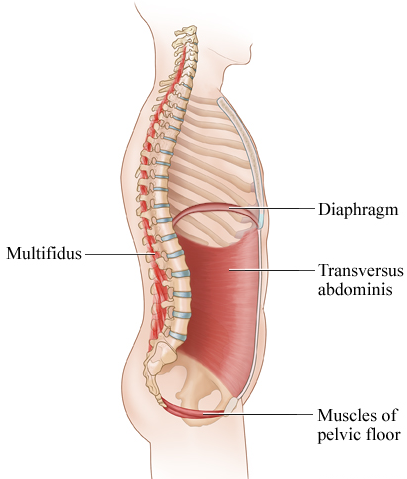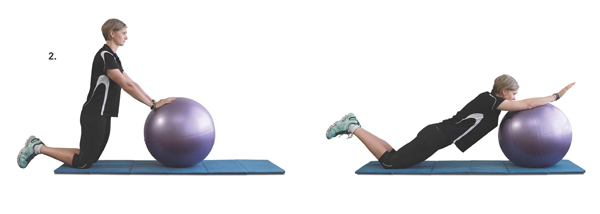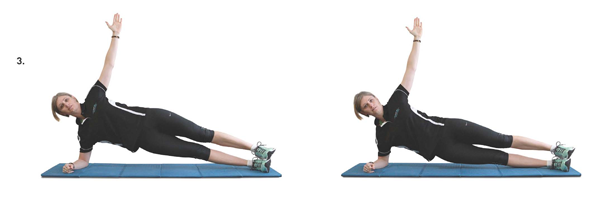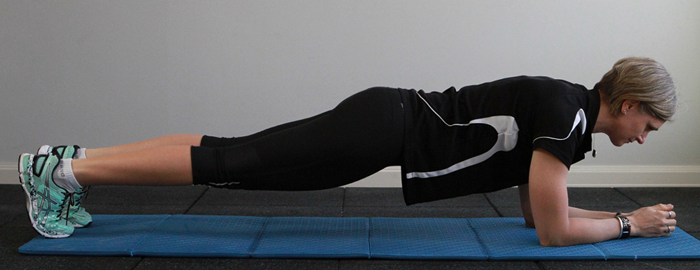‘Core strength’ has been a fitness buzzword for a number of decades now – Tammy Curtis clears up the confusion of what it actually means.
Do you ever notice some cyclists just make riding look easy? Their pedal stroke is smooth, balanced, almost effortless, they have great acceleration and they barely move their upper body. Rarely do you see their hips seesaw in the saddle or hear them complain of back pain. These riders all have one thing in common, a strong core.
So what really is core strength?
 Let’s start with what muscles make up the core. Any muscles that are attached to the spine or pelvis are part of what makes up the core collectively but can be classified as either part of the ‘inner’ or ‘outer’ unit.
Let’s start with what muscles make up the core. Any muscles that are attached to the spine or pelvis are part of what makes up the core collectively but can be classified as either part of the ‘inner’ or ‘outer’ unit.
The ‘inner unit’ could be described as cylindrical in shape with muscles including the diaphragm, pelvic floor, transverse abdominis and multifidus. You will feel these muscles contract if you were to brace as someone pokes you in the stomach. An easy way to visualise this is to think of an apple as your trunk, once you have eated all around the apple you are left with just the core to support your spine.
The ‘outer unit’ consists of larger muscles of the trunk and hips that produce gross movement and work in conjunction with the inner unit including rectus abdominis, obliques, gluteals, hip flexors, latissimus dorsi, abductors and adductors.
So how does this relate to making me a better cyclist?
When both your inner and outer units (core muscles) are strong and working together as a team, they provide stabilisation of the hips and spine. When you then add movement of a pedal stroke, your core muscles have to provide dynamic stabilisation as a base to transfer power created from the legs directly into the pedals. Without this stabilisation, power can be lost through the hips and riding suddenly becomes inefficient and a lot harder. You may start to feel an over emphasised side-to-side rocking motion through your upper body as it tries to gather momentum and you will notice your balance waiver as your steering weaves along the road. This will significantly reduce your power output. If this sounds like you, then it’s time to focus on strengthening your core.
Some key things to know about core exercises
Contrary to popular belief, crunches are an isolation outer abdominal exercise, not a deep core exercise. They are also not a practical exercise for cyclists as they may result in over strengthening of the outer abdominals. Remember that on your bike you are already in forward flexion and slightly rounded when in aerodynamic position – if your abdominals are strong but there is not a balance of strength deep around the spine plus front and back of the torso, back pain and postural issues may result. You also don’t want to make your slightly rounded bike position habitual off the bike.
When completing core exercises most people have a natural tendency to brace their core muscles and forget to breathe. Redness appears in the face, neck veins emerge, dizziness may be felt and fatigue will set in fast. This is not ideal and is dangerous for people suffering from hypertension. So in order to be safe and effective, brace your core but remember to breathe.
Choosing exercises to work the core can be confusing. Fundamentally a plank is a great place to start. This will not only teach you to engage and brace the core muscles but will give you time to practice a breathing rhythm. Once you have mastered a plank hold for one minute then you are ready to progress to movement based core exercises. This is where the magic happens. When you are able to combine using your inner and outer units together in a more functional movement pattern the body will work efficiently and with control. Below are four of my favourite core exercises that can revolutionise the way you ride.
A regular regimen of core exercises will add a noticeable difference to your power, acceleration and efficiency on your bike as well as improving posture and reducing your chances of injury. Having strong legs is one thing, but without a strong core foundation the power transfer is lost and it can feel like you’re pedalling through sand. Nobody likes that feeling!
For the best program for your individual needs, see your doctor or a fitness professional.

Slow BOSU mountain climbers
This variation of the traditional ‘mountain climber’ exercise adds two elements; balance and control.
- Place your hands on opposite edges of a BOSU ball (dome down);
- Set your body in push-up position and brace core (start position);
- Elevate your right leg and drive that knee to the right elbow slowly;
- Return to the start position slowly and with control.
Alternate sides, with 2–3 sets of 20.
 Swiss ball roll outs
Swiss ball roll outs
This exercise utilises the corset-like muscle, transverse abdominis.
- Kneel with a Swiss ball in front, with your hands on top of ball;
- Align your knees, hips and shoulders and lock the elbows out (start position);
- Roll the ball forward until your shoulders also align;
- Return back to start position by pressing your arms down into the ball while maintaining knee, hip and shoulder alignment.
Do 2–3 sets of 10.
 Side plank hip drops
Side plank hip drops
Progress a static side plank to a movement based variation.
- Lie on your right side, propped on your forearm with feet stacked;
- Raise your hip to align with shoulders, knees and ankles;
- Extend your left arm to point skyward (start position);
- Keeping your body in the same plane, drop the hips almost to the ground;
- Return to start position of alignment.
Alternate sides, with 2–3 sets of 10 each side.
 Snow angels
Snow angels
Engage middle and lower back utilising multifidus and back extensors.
- Lie face down on a mat with your arms extended alongside your body and palms up (start position);
- Lift your chest, shoulders and hands from the ground and squeeze glutes;
- Keep your arms straight and sweep overhead to touch fingers in front of head;
- Sweep arms back to starting position.
Do 2–3 sets of 10.
Tammy Curtis is a personal trainer, educator and former athlete based in Ashburton, Melbourne (www.fitforall.net.au)
Ride On content is editorially independent, but is supported financially by members of Bicycle Network. If you enjoy our articles and want to support the future publication of high-quality content, please consider helping out by becoming a member.

